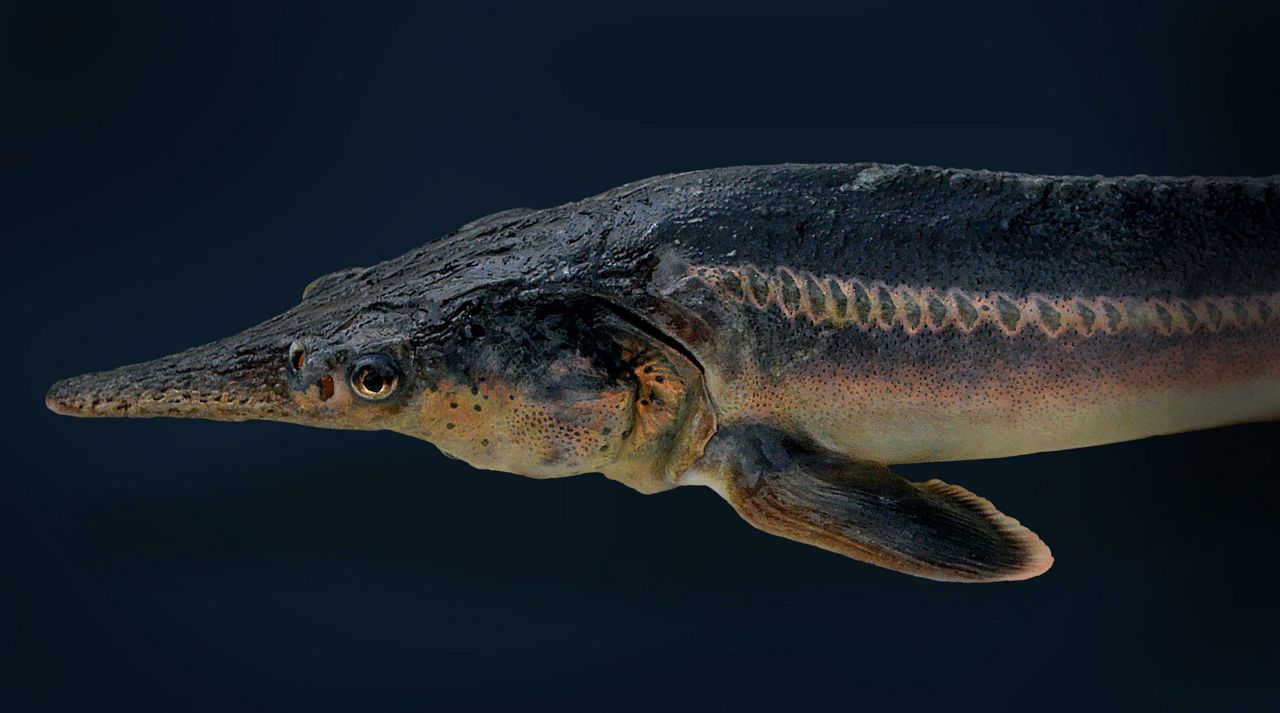FRANKFORT, Ky. – Corn Flakes. Teflon. The Slinky. These are just some of the more common items invented by accident. Perhaps less common but inadvertently created nonetheless, is the "sturddlefish."
What You Need To Know
- Kentucky State University professor part of research team
- Species was created by accident
- Could be valuable in research
- Fish being kept in captivity in Hungary
Kentucky State University assistant professor in aquaculture Dr. Ken Semmens called the hybrid species the result of “biological curiosity.” Semmens has been working with paddlefish since the 1980s and was part of the team that created the sturddlefish, which is a cross between the American paddlefish and the Russian sturgeon.
“The paddlefish is something that Kentucky State has been known for, and I had worked with long before I came here,” Semmens, in his fifth year at the university, said.
The hybrid fish species was created unintentionally during attempts to induce gynogenesis, a type of reproductive fertilization where a sperm cell must be present to trigger an embryo’s development but does not genetically contribute to the offspring.
The study’s initial goal was to encourage the sturgeon, which produces roe that is sold as caviar, to reproduce asexually. The paddlefish was initially intended to provide sperm – not DNA – to help the sturgeon reproduce independently. The DNA of the sperm specimen is not supposed to transfer to the offspring in gynogenesis.
“You would expect that if you have a caviar-bearing fish, you would want to produce all females because more females mean more eggs,” Semmens said. “You don’t want all males, and then there’s no eggs – the value of the fish is much less. There has been through the years an interest in trying to produce a population with all females. The expectation was that if you took paddlefish milk and fertilized a sturgeon egg, nothing would happen. When they crossed the Russian sturgeon eggs with milk or spermatozoa in the milk, the expectation was it would not hybridize from the paddlefish.”

Instead, hundreds of sturddlefish were created, of which about two-thirds survived over one month, and about 100 survived for one year and are currently being kept in captivity at a research lab in Hungary. The experiment marks the first time the sturgeon and paddlefish have been successfully hybridized in captivity. The two fish would never have met naturally, as the American paddlefish dwells in the Mississippi River Basin, and the Russian sturgeon inhabits Russian rivers, Semmens said.
“The case with myself and others who have taken sturgeon from our waters and tried to make the hybrid is we get nothing. It does not develop,” Semmens said. “Maybe the egg will start to develop, but it does not complete development. It does not hatch. These guys over in Hungary don’t have the same species of sturgeon to work with that we do. We have the shovelnose sturgeon. They have Russian sturgeon. It turns out there are some differences there, and that was important.”
The discovery has garnered international attention partly because both the American paddlefish and Russian sturgeon are endangered species threatened by shrinking habitats and overfishing.
A sturddlefish’s appearance is derived from its mother, the Russian sturgeon, which are carnivores with creamy bellies, short, rounded snouts and green, dragon-like scales, and its American paddlefish father, which are smooth-skinned filter feeders with sensitive, elongated snouts.
There were two types of sturddlefish created: One of them is one part paddlefish, two parts sturgeon, and the other is one part paddlefish, four parts sturgeon. The two species likely hybridized because the sturgeon was slow to evolve. There are likely fewer differences between its morphology and genes and those of other species, such as the American paddlefish.
“It being an inadvertent discovery, we’re sort of asking the same questions anybody else would,” Semmens said. “Can you spawn on them? We don’t know. Can you cross a triploid with a pentaploid and get a tetraploid? I don’t know. They look more like the sturgeon than they do the paddlefish, and there’s no telling why that’s so. It could be that certain configurations are not viable, and those that survived are what we see.”
While crossbreeds such as mules and ligers sit close together on the tree of life, sturddlefish result from the merger of different taxonomic families. Aquaculturists had previously used sperm from paddlefish to trigger gynogenesis in other sturgeon species, but none of those experiments had ever produced crossbreeds.
“It’s not what I would call a breakthrough fish, it’s more of a curiosity,” Semmens said. “It may be that there are more biological questions that can be asked and answered with this than commercial solutions.”
The research team believes that if sturddlefish end up not needing to be fed and instead rely on natural plankton in their habitats, the carbon emissions that would have resulted from feeding them will shrink. The researchers said that Sturgeon hybrids are typically used in aquaculture and provide around 20 percent of global caviar production. But suppose the hybrids adopt the paddlefish parents’ habits and learn to feed on plankton and other microscopic organisms instead of the sturgeon’s diet of crustaceans and more substantial fare. In that case, they may play “an important role in adapting pond aquaculture to the challenges of climate change,” according to the research team.
Semmens also believes the successful hybridization could be the result of the Russian sturgeon’s extra-large genome. Studies of the new fish could also provide insight into how genomes work.
The study was conducted at the Research Institute for Fisheries and Aquaculture in Hungary by the team of Semmens, aquaculture engineer Jenő Káldy, fish ecologist Attila Mozsár and aquacultural geneticist Miklós Bercsényi of the University of Pannonia. The team will soon collaborate with researchers in Japan and elsewhere to study the sturddlefish. For now, the hybrids live at the research facility in Hungary, where there’s no risk they’ll invade non-native waters.
“It costs money to hold these things,” Semmens said. “One thing you don’t want to do with something like this is just let it go. You don’t go stocking the natural streams and lakes with these things because it’s just imprudent to make a hybrid and do something like that. These fish could be used for aquaculture, and undoubtedly they will evaluate them for that purpose.”



